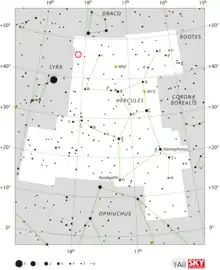DQ Herculis
DQ Herculis, or Nova Herculis 1934, was a slow, bright nova occurring in the northern constellation of Hercules in December 1934. This cataclysmic variable star was discovered on 13 December 1934 by J. P. M. Prentice from Stowmarket, Suffolk.[12] It reached peak brightness on 22 December 1934 with an apparent magnitude of 1.5.[3] The nova remained visible to the naked eye for several months.[13]
 RGB composite color image of the shell surrounding the nova DQ Her, made from three narrow band images: Blue = 4800Å, green = Hα at 6563 Å and red = [NII] at 6583 Å. From Santamaria et al. 2020[1] | |
| Observation data Epoch J2000 Equinox J2000 | |
|---|---|
| Constellation | Hercules |
| Right ascension | 18h 07m 30.25108s[2] |
| Declination | +45° 51′ 32.5646″[2] |
| Apparent magnitude (V) | 1.5[3] - 15.16[4] |
| Characteristics | |
| Spectral type | DBe + M2V |
| Variable type | DQ Her[5] |
| Astrometry | |
| Proper motion (μ) | RA: −0.948[2] mas/yr Dec.: +12.423[2] mas/yr |
| Parallax (π) | 1.9975 ± 0.0237[2] mas |
| Distance | 1,630 ± 20 ly (501 ± 6 pc) |
| Absolute magnitude (MV) | −6.94[6] |
| Orbit | |
| Period (P) | 0.1936208977 ± 0.0000000017 d[7] |
| Semi-major axis (a) | 0.003 AU |
| Inclination (i) | 86.5±1.6[8]° |
| Details | |
| A | |
| Mass | 0.6[9] M☉ |
| Radius | 0.0121[8] R☉ |
| B | |
| Mass | 0.4[9] M☉ |
| Other designations | |
| Database references | |
| SIMBAD | data |

This is a binary star system consisting of a white dwarf primary with an estimated 60% of the mass of the Sun and a red dwarf secondary with 40% of the Sun's mass.[8] They orbit each other tightly with a period of 4.65 hours.[7] The system shows orbital period variation, possibly due to the presence of a third body.[5] The orbital plane of the pair is inclined by an angle of 86.5° to the line of sight from the Earth, causing the white dwarf to undergo a deep eclipse every orbit.[8]
DQ Herculis is the prototype for a category of cataclysmic variable stars called intermediate polars.[5] The red dwarf has filled its Roche lobe and matter is being drawn off at the rate of 2.7 × 10−9 M☉ yr−1, forming an accretion disk orbiting the primary. This disk has inferred temperatures ranging from 5,000 to 13,500 K. A bright spot in the inner disk appears to pulsate with a 71-second period. In this class of variables, the white dwarf is magnetized, directing infalling matter onto the magnetic poles.[8]

The shell of ejected material from the nova outburst is visible as an emission nebula, similar in appearance to a planetary nebula. This roughly elliptical nebula had a size of 32.0 × 24.2 arc seconds as of 2018, and it is expanding at a rate of about 0.16 arc seconds per year.[1]
In popular culture

The nova was one of the brightest objects observable in the night sky. In addition to scientific articles, and received significant coverage in popular news publications.[14][15] Brad Ricca, an English professor at Case Western Reserve University, has suggested that Nova Herculis may have influenced the development of the origin story of the comic book superhero Superman.[16]
References
- Santamaria, E.; Guerrero, M.A.; Ramos-Larios, G.; Toala, J.A.; Sabin, L.; Rubio, G.; Quino-Mendoza, J.A. (March 2020). "Angular Expansion of Nova Shells". The Astrophysical Journal. 892 (1). arXiv:2002.06749. doi:10.3847/1538-4357/ab76c5. Retrieved 6 December 2020.
- Brown, A. G. A.; et al. (Gaia collaboration) (August 2018). "Gaia Data Release 2: Summary of the contents and survey properties". Astronomy & Astrophysics. 616. A1. arXiv:1804.09365. Bibcode:2018A&A...616A...1G. doi:10.1051/0004-6361/201833051. Gaia DR2 record for this source at VizieR.
- Wright, W. H. (1935). "Comments on Nova Herculis 1934". Publications of the Astronomical Society of the Pacific. 47 (275): 47–49. Bibcode:1935PASP...47...47.. doi:10.1086/124534. JSTOR 40670634.
- Norton, A. J.; et al. (2007). "New periodic variable stars coincident with ROSAT sources discovered using SuperWASP". Astronomy and Astrophysics. 467 (2): 785–905. arXiv:astro-ph/0702631. Bibcode:2007A&A...467..785N. doi:10.1051/0004-6361:20077084. S2CID 16358048.
- Dai, Z. B.; Qian, S. B. (2009). "Plausible explanations for the variations of orbital period in the old nova DQ Herculis". Astronomy and Astrophysics. 503 (3): 883–888. Bibcode:2009A&A...503..883D. doi:10.1051/0004-6361/200810909.
- Harrison, Thomas E.; et al. (2013). "Hubble Space Telescope Fine Guidance Sensor Parallaxes for Four Classical Novae". The Astrophysical Journal. 767 (1). 7. arXiv:1302.3245. Bibcode:2013ApJ...767....7H. doi:10.1088/0004-637X/767/1/7. S2CID 118376206.
- Schaefer, Bradley E. (March 2020). "Sudden and steady orbital period changes across the classical nova eruptions of DQ Her and BT Mon". Monthly Notices of the Royal Astronomical Society. 492 (3): 3323–3342. arXiv:1912.06169. Bibcode:2020MNRAS.492.3323S. doi:10.1093/mnras/stz3325. S2CID 209370404.
- Saito, R. K.; et al. (June 2010). "Spectral Mapping of the Intermediate Polar DQ Herculis". The Astronomical Journal. 139 (6): 2542–2556. arXiv:1005.1612. Bibcode:2010AJ....139.2542S. doi:10.1088/0004-6256/139/6/2542. S2CID 118447217.
- Zhang, E.; et al. (November 1995). "The 71 Second Oscillation in the Light Curve of the Old Nova DQ Herculis". Astrophysical Journal. 454: 447. Bibcode:1995ApJ...454..447Z. doi:10.1086/176496.
- "DQ Her". SIMBAD. Centre de données astronomiques de Strasbourg. Retrieved 2020-11-14.
- Rosenbush, A.E. (January 1999). "On the possibility of systematizing classical novae by light curve type. I. Type criteria". Astrophysics. 42 (1): 43–53. doi:10.1007/BF02700913. Retrieved 6 December 2020.
- "DQ Her". www.britastro.org. Retrieved 2017-08-09.
- "Nova Herculis, Discovered in December 1934, Varies From First to Thirteenth Magnitudes--Now Fading, About Sixth". 1935-12-07. Retrieved 2013-08-08.
- Kaempffert, Waldemar (1934-12-23). "The Week In Science: STAR OF BETHLEHEM A NOVA?; Recent Brilliant Outburst Recalls the Orb the Magi Followed". The New York Times. Retrieved 2013-08-08.
- "Science: Nova Herculis; Swaseya". Time. 1934-12-31. Retrieved 2013-08-08.
- "Superman's Origins Possibly Born from Star Explosion". 2013-07-12. Retrieved 2013-08-07.